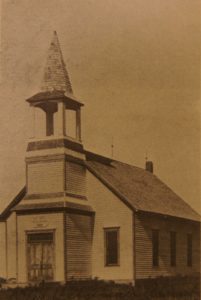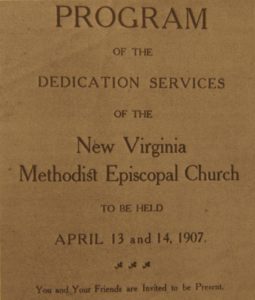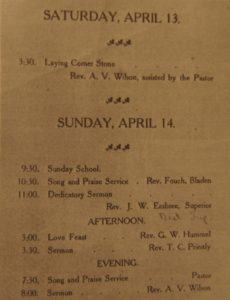The Virginians and other early residents in the southeast area of Catherton precinct built a church seven and a half miles north of Inavale in the northwest corner of the SW 1/4 of section 26. The present church is the second structure that was built. It is one of the two remaining country churches left in Webster County. The other one is the Dane church, or St. Stephens, in Batin precinct.
The Bladen Enterprise reported on September 15, 1905 that the New Virginia church construction was being “pushed right along.” Svend Lindquist was the carpenter, a Danish farmer-carpenter, then living in Batin precinct. The church dimensions were 28×40 feet. The roof was being put on and the congregation hoped to have it ready for dedication in November. Its cost was $1,652 and was erected under the superintendency and guaranty of Ed Payne and Clarence Wilson. These two men had contributed the two largest sums to the building fund, with John Wilson, Mrs. Marker and E.J. Peterson also large contributors. At that time the New Virginia church was thought to have the largest and most expensive rural church edifice in the county. It had a membership of 30 and an attendance of 75, with a Sunday School of 50.
Unknown problems delayed the dedication for the Bladen Enterprise on August 10, 1906 reported that the dedication of the New Virginia church building which was to have taken place the past Sunday, (August 6) had been postponed until Sunday, August 19, 1906. A fire of unknown origin destroyed the new church Saturday night before it was to be dedicated the following day – Sunday. *
John Marker then lived across the road from the building site and had gone by the church about dusk and had not noticed anything unusual. However, one mule of his team became frightened and difficult to handle. He got the team quieted down and went on home. When he came from the barn, the church as ablaze. While help was called there was no means to put out the blaze, so the structure was entirely destroyed.
On Sunday morning, the congregation gathered at the school house (District 65) and after a short sermon by the District Superintendent, who had come for the anticipated dedication, the congregation discussed their loss. They decided to use the $1,000 insurance monies and to request the balance needed by subscription.
Enough money was obtained by subscription at great sacrifice to the members, so that rebuilding could begin immediately. A new structure was built by Fred Gaveka, and Inavale carpenter, at a cost of $1,650. Masonry work on the chimney was the work of Allen A. “Al” Cooper. The new church was dedicated April 14, 1907. While the church’s name came about because many of the original congregation came from the Shenandoah Valley area of Virginia, many German and Swedish families were charter members. Family names connected with the New Virginia Methodist Episcopal church include: The Wilson Brothers, Clarence, Albert and John; Alford Marker and sons, John and Ford; J.B. Wisecarver; Richard T. Payne and sons, Frances E. “Ed” and Bruce; A.A. Cooper; William Matheny; Henry Williams; Daniel Lovejoy; Eric John Peterson; Henry and Carl Lambrecht; Swan Johnson; with the Jay Lovejoy and Rolly Brooks families becoming members sometime later.
Pastors of the New Virginia Methodist Episcopal church were recalled by Ray Wilson, a longtime church superintendent, who generously served the New Virginia church with his time, energy and money.
Before 1905 New Virginia was part of the Bladen charge, and Rev. T.C. Priestly was the first minister after the second church was built. He was followed by Folden John Bean, E.A. Van Dyke, McVey Hancock, Blackwell Wilson, and Priestly Bromwell.
R.B.E. Hill served from September 24, 1905 to July 18, 1909. The following pastors served the New Virginia Church in later years: H.M. Bassett, Sept. 1910-1911; M.C. Smith 1911-1914; Scott Blunt, 1914-1915; A.E. Murless, 1916-1917; J.W. Borden 1918-1919; Charles E. Schofield 1920-1922; David Simpson 1922-1923; M.E. Henry 1923-1925; Glen W. Marshall, 1925-1928; O.L. Bebb 1928-1929; H.B. Lansing, 1930; C.O. Freeman, 1931-1932; C.C Warriner, September 1933; P.J. Kirk, 1934-1935; O.R. Kleven, 1936 as an evangelist, with C.C. Eston as pastor while Rev. Kleven was holding revivals; Earl L. Russell, September 1937-February 11, 1938; W.A. Mansur, February 11, 1938-September 1939; Ralph Good, 1940-1942; Leslie Moore, 1951. In 1942 ministers were not plentiful, and Inavale became part of the Red Cloud charge. New Virginia then did not have a pastor, but community church services and Sunday school continued with Ray, Norva and Mayme Wilson, Rollie and Veda Brooks, Grace and Margaret Lambrecht and others in the community doing what they could to keep the church active. In 1950 the New Virginia charge was reopened for a short time. The families in the community gathered for a carry-in noon meal, that was followed by a religious service conducted by lay people in the community or by a minister from Red Cloud that was willing to accommodate a rural congregation on occasion.
Lloyd Crabill was the first Sunday School Superintendent of the New Virginia church, and it was he who suggested the name for the new church. The congregation participated in annual Sunday School conventions which included the congregations at Plainview, District 66, Pleasant Prairie and New Virginia – District 65. The New Virginia Ladies Aid was organized in 1907 and is still an active organization.
* Many thought the fire was connected with Rev. R.B.E Hill’s attempt to remove boot-leg liquor from Inavale.
Source:
Webster County: Visions of the Past
By Mabel Cooper Skjelver
Published 1980
Pages 80-82




Leave a Reply